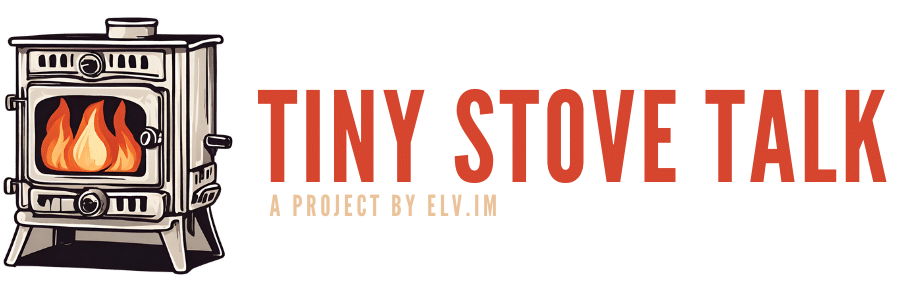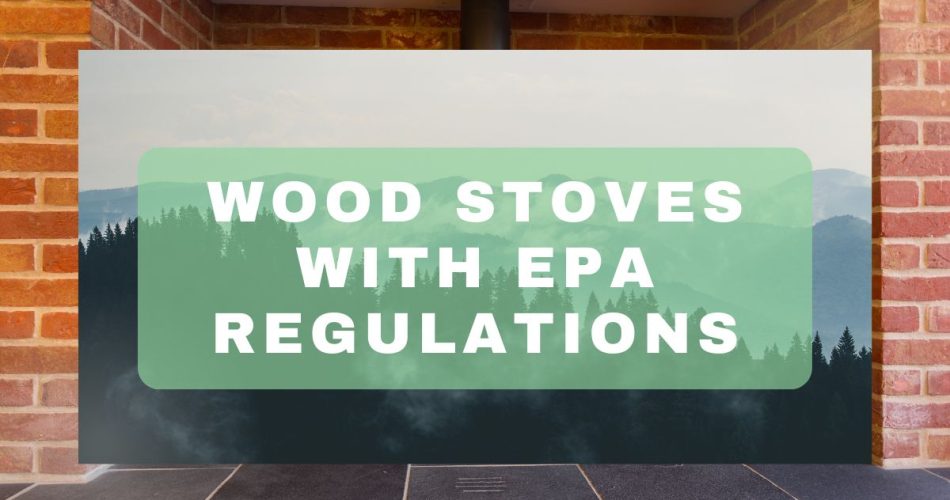Here is some information about wood stoves with EPA regulations, organized in tables and bullet points. I’m using CB-1008 CUB Cubic Mini Wood Stove, and I’m more than satisfied.
What are EPA Certified Wood Stoves
-
- These are wood stoves that have been independently tested by an accredited laboratory to meet a particulate emissions limit of no more than 4.5 grams of smoke per hour (g/h) under Step 1 of the revised standards of performance for wood burning room heaters.
- Step 2 took effect on May 15, 2020, when the standard was lowered to 2.0 g/h for wood stoves and 2.5 g/h for cordwood tested wood stoves.
- You can find a list of EPA-certified wood stoves here.
Compliance Requirements for Residential Wood Heaters
-
- These are the updated clean air standards for residential wood heaters that were issued by the EPA on February 3, 2015.
- The standards apply to new wood heaters and not to wood heaters already in use in homes.
- The standards cover four types of wood heaters: woodstoves and pellet stoves, wood-fired hydronic heaters, wood-fired forced air furnaces, and single burn-rate wood stoves.
- The table below summarizes the requirements for each type of wood heater.
| Type of Wood Heater | Emission Limit (g/h) | Compliance Deadline |
|---|---|---|
| Woodstoves and Pellet Stoves | 4.5 (Step 1), 2.0 (Step 2) | May 15, 2015 (Step 1), May 15, 2020 (Step 2) |
| Wood-fired Hydronic Heaters | 0.32 lb/mmBtu heat output (Step 1), 0.15 lb/mmBtu heat output (Step 2) | May 15, 2015 (Step 1), May 15, 2020 (Step 2) |
| Wood-fired Forced Air Furnaces | 0.93 lb/mmBtu heat output (Step 1), 0.15 lb/mmBtu heat output (Step 2) | May 15, 2016 (Step 1), May 15, 2020 (Step 2) |
| Single Burn-rate Wood Stoves | 4.5 (Step 1), 2.5 (Step 2) | May 15, 2015 (Step 1), May 15, 2020 (Step 2) |
Choosing the Right Wood-Burning Stove with EPA Rating
Wood-burning stoves are a popular and efficient way to heat your home, but they also have environmental and health impacts. That’s why it’s important to choose a wood-burning stove that meets the EPA’s emission standards and suits your heating needs.
What is the EPA Rating?
The EPA rating is a measure of how much smoke a wood stove produces per hour, expressed in grams per hour (g/h). Smoke is composed of fine particles, gases, and other pollutants that can harm your health and the environment. The lower the g/h rating, the cleaner and more efficient the wood stove is.
The EPA has set emission limits for new wood stoves since 1988, and has revised them in 2015 and 2020. The current emission limits are as follows:
- Woodstoves and pellet stoves: 4.5 g/h (Step 1), 2.0 g/h (Step 2)
- Wood-fired hydronic heaters: 0.32 lb/mmBtu heat output (Step 1), 0.15 lb/mmBtu heat output (Step 2)
- Wood-fired forced air furnaces: 0.93 lb/mmBtu heat output (Step 1), 0.15 lb/mmBtu heat output (Step 2)
- Single burn-rate wood stoves: 4.5 g/h (Step 1), 2.5 g/h (Step 2)
Step 1 took effect on May 15, 2015, and Step 2 took effect on May 15, 2020. The standards apply to new wood stoves and not to wood stoves already in use in homes. You can find a list of EPA-certified wood stoves here.
What Types of Wood Stoves are Available?
There are two general approaches to meeting the EPA emission limits: non-catalytic and catalytic combustion. Both approaches have proved effective, but there are performance differences. Here is a brief overview of each type:
Non-catalytic Wood Stoves
Non-catalytic wood stoves do not use a catalyst but have three internal characteristics that create a good environment for complete combustion. These are firebox insulation, a large baffle to produce a longer, hotter gas flow path, and pre-heated combustion air introduced through small holes above the fuel in the firebox.
Non-catalytic wood stoves are simpler to operate and maintain than catalytic wood stoves, and have less risk of clogging or degrading the catalyst. However, they may not burn as consistently or cleanly as catalytic wood stoves, and may require more frequent reloading of wood.
Catalytic Wood Stoves
Catalytic wood stoves use a catalyst, which is a ceramic or metal device coated with a metal that reduces the ignition temperature of the smoke. The catalyst is located in the stove’s smoke path, and when the smoke passes through it, it ignites and burns.
Catalytic wood stoves can produce a long, even, and clean burn, and can extract more heat from the wood than non-catalytic wood stoves. However, they are more complex to operate and maintain than non-catalytic wood stoves, and require periodic replacement of the catalyst, which can be expensive.
How do you select the right wood stove for your home?
Choosing the right wood stove for your home depends on several factors, such as the size and efficiency of the stove, the type and quality of the wood, the installation and maintenance of the stove, and the safety and health of your family and neighbors. Here are some tips to help you make the best decision:
- Choose a wood stove that is EPA-certified and has a low g/h rating. This will ensure that you are getting a clean and efficient wood stove that meets the current emission standards.
- Choose a wood stove that is the right size for your heating needs. A stove that is too large will produce more heat than you need, and may cause overheating, creosote buildup, and air pollution. A stove that is too small will not provide enough heat and may require more frequent reloading of wood. You can use this calculator to estimate the size of the stove you need.
- Choose a wood stove that matches your preferences and lifestyle. If you like simplicity and convenience, you may prefer a non-catalytic wood stove. If you like technology and performance, you may prefer a catalytic wood stove. You can also consider other features, such as the design, the shape, the color, the door, the glass, the ash pan, the blower, and the accessories of the stove.
- Choose a wood stove that is installed and maintained properly. You should hire a professional installer who follows the manufacturer’s instructions and the local codes and regulations. You should also inspect and clean your stove and chimney regularly, and use a carbon monoxide detector in your home. You can find more information on installation and maintenance here.
- Choose a wood stove that is safe and healthy for you and your neighbors. You should use dry, seasoned, and split hardwood that has been stored for at least six months. You should also follow the best practices for lighting, loading, and operating your stove, such as using newspaper and kindling, keeping the fire hot, and avoiding smoldering. You can find more tips on burning wisely here.
Top Best EPA Rated Wood Stoves
| Brand | Heating Capacity | Efficiency | Max Log Length | Max Burn Time | Average Price |
|---|---|---|---|---|---|
| Lopi Rockport | Up to 2,000 sq. ft. | 79% | 18″ | 8 hours | $2,500 |
| Regency F2400 | Up to 2,500 sq. ft. | 75% | 18″ | 10 hours | $2,200 |
| Quadra-Fire Explorer III | Up to 3,200 sq. ft. | 80% | 20″ | 12 hours | $3,000 |
| Pacific Energy Alderlea T5 | Up to 2,000 sq. ft. | 77% | 16″ | 8 hours | $2,600 |
| Hearthstone Heritage | Up to 2,000 sq. ft. | 80% | 18″ | 10 hours | $2,800 |
| Jotul F 500 Oslo | Up to 2,000 sq. ft. | 75% | 20″ | 9 hours | $2,400 |
| Osburn Matrix 2700 | Up to 2,700 sq. ft. | 74% | 20″ | 10 hours | $2,300 |
| Drolet HT2000 | Up to 2,400 sq. ft. | 78% | 18″ | 9 hours | $2,100 |
Conclusion
Wood-burning stoves are a great way to heat your home, but they also require careful selection and use. By choosing a wood stove that has an EPA rating, you can reduce your environmental and health impacts and enjoy a cozy and comfortable home.
We hope this article has helped you understand what the EPA rating means, what types of wood stoves are available, and how to select the right one for your home.
I’m using CB-1008 CUB Cubic Mini Wood Stove, and I’m more than satisfied.



[…] good thing about these wood stove manufacturers is that almost all their products are EPA 2020 compliant. But if the wood stove doesn’t have an EPA rating, don’t be discouraged to buy it […]
[…] Look for this EPA-endorsed label before purchasing your heating system, regardless of fuel type. Check to see if the models you’re considering meet these EPA requirements when comparing wood and … […]
[…] Aside from standards for chimney pipes, you should also check safety standards for wood stoves, like the EPA Regulations. […]